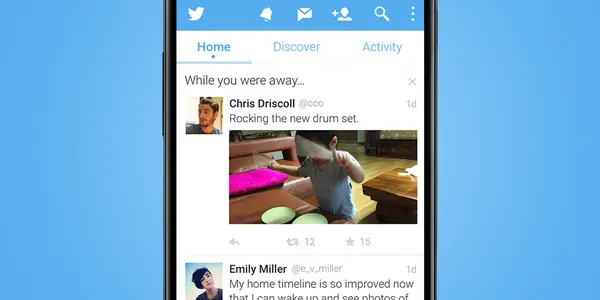Wait a minute, Algorithms on Social Media?
Yes, they’re like little data puzzles waiting to be solved for social media marketers and marketing agencies.
The good news is Social algorithms are not as mysterious or malicious as you might believe.
We all know that having a social media strategy can be a potent tool for businesses when it comes to digital marketing.
Keep in mind that social media algorithms have a huge impact on the performance of your content. Since social media algorithms determine how much and who sees your posts, you must understand them in order to ensure that your social media is as effective as possible.
Do you want to know more about social media algorithms and how they can help your business succeed on social media?
Then this detailed blog is for you.
So, let’s get started.
Algorithms are a method of monitoring and managing content and social media accounts for today’s 4.55 billion social media users. The amount of data sent every minute or second is incomprehensible.
However, there is a method by which social media platforms keep order, sort data, and rank it. A social media algorithm accomplishes this.
The mathematical rules that govern how users see content on their social media accounts are known as social media algorithms. They sort feed posts based on the relevance of the published content to a specific user, as determined by user behavior. They want traffic to keep flowing into their platforms, so sometimes relevance takes precedence over chronological order.
Because social media algorithms are constantly changing and dynamic in nature, it is critical for digital marketers and business owners to understand them thoroughly.
Before promoting posts on social media, social media algorithms consider the following factors:
- Publishing date
- Engagement rate
- User preferences
- Alt Text
- Hashtags
- Type of content
A social media algorithm’s goal is to provide users with relevant content. The aim of using algorithms on social media networks is to sift through the vast amount of content available on each platform more organically.
Algorithms are responsible for delivering content that is potentially more “interesting” for a user. It ignores content that is deemed irrelevant or low-quality, either in general or for a specific person.
Without social media algorithms, skimming through all posts on an account-by-account basis would be difficult.
Now that we got a glimpse of social media algorithms let’s analyze how different social media platforms use the algorithm to enhance user experience.
Different platforms use various social media algorithms. As a result, it is advised to hire or consult with a top digital marketing agency that specializes in social media marketing and is up to date on the latest algorithm updates on various platforms.
Now let’s talk about the largest social media platform’s algorithm and some tips to stand out from the crowd.
Facebook Algorithm Explained:

The key to Facebook’s algorithm design is meaningful customer engagement. It was designed to increase the importance and viewership of local, familial, and friendly posts over business posts.
Many changes to Facebook’s algorithm have occurred over the years, making it difficult to get posts, particularly organic ones, in front of the right people without planning and strategizing.
It’s made up of four ranking signals:
- Popularity
- Content type
- Relationship
- Recency
Organic reach on social media is declining. On Facebook, this means that the average reach for an organic post has dropped by more than 5%, while the engagement rate is only 0.25 percent, dropping to 0.08 percent if you have more than 100k followers.
Paid Facebook content is ranked separately, but it is still based on engagement, customer response, and subject matter relevance.
Some helpful tips on how to beat the Facebook algorithm:

- Building connections is essential for ensuring that your brand responds to comments or inquiries.
- Use Facebook Stories because they do not appear in the newsfeed and thus do not rely on the algorithm to be seen.
- Because live video generates more engagement, it is preferred by the algorithm.
- Before posting external content, make sure it is credible and not misleading.
Now let’s find out how many businesses thrives in the Insta marketing game.
Instagram Algorithm Explained (In 2022):

Instagram’s algorithms differ depending on the type of content: News Feed, Reel, Explore page, and Stories.
For News feed:
Instagram discovered that people prefer to see their friends’ posts in their feed, so the algorithm collects data and forecasts to provide you with the best possible experience.
The Instagram feed algorithm is built around the following information:
- Post Stats: Rate of engagement (likes, comments, and shares), date of publication, hashtags, location tags, and user mentions
- Interactions in the Past: The amount of interaction you have with other users influences how frequently and where you see their content in your feed.
- Your Activity: The type of posts you’ve recently liked or commented on influences the content you’ll see in your feed shortly.
- Profile searched: Checking some Instagram accounts more frequently than others may result in their content appearing more frequently in your feed.
For Reels:
Instagram prioritizes Reels in the same way that it prioritizes feed posts—based on what it believes a user will interact with the most.
Instagram is promoting Reels as the company’s next flagship feature. Instagram CEO Adam Mosseri has stated publicly that he wants to go big on video in order to compete directly with TikTok.
For Stories:
The Instagram Stories that appear first in your feed are the most engaging for you. They’re from the profiles you interact with the most, whether you like, reshare, comment on, or save their content.
As Instagram stories are short-lived, timeliness is less important — but it can have a slight impact on ranking once a story reaches 10+ hours.
Keeping this in mind, it’s a good idea to share Instagram Stories that encourage engagement on a regular basis: poll, question, and quiz stickers are all excellent ways to drive interactions.
For Explore Page:
Instagram’s algorithm analyses posts that users have previously interacted with and then displays content from related accounts that the user does not follow for the Explore page ranking.
The algorithm is based on how likely users are to share, like, or save a post, as well as how they interact with specific hashtags. These can include both personal and professional information.
Some helpful tips on how to beat the Instagram algorithm:
- Schedule your posts for the best times.
- Add Reels to your Instagram marketing strategy.
- To gain visibility, use hashtags.
- Instagram stickers can help you increase engagement.
- You must post regularly if you want to increase your followers, reach, or engagement.
- Tracking and monitoring your performance on Instagram is one of the most effective ways to gain favor with the algorithms.
Now, Let’s understand how the Twitter algorithm works.
Twitter Algorithm Explained:

Whereas Facebook makes most of the decisions about what appears in your Facebook News Feed, Twitter has historically taken a very different approach with its “Timeline.”
When you first log in, your Timeline displays a stream of tweets from the users you follow on your account home page. Your Timeline used to be made up of every single tweet from every user you followed, in chronological order.
But, as with Facebook, Twitter discovered that users felt they were missing all of the best tweets from the people they cared about the most.
The changes to the Twitter algorithm aren’t nearly as platform-changing as those made by Facebook, but they are a departure from the real-time element that has defined Twitter since its inception.
The “While You Were Away” Feature:

This feature was added in an attempt to alleviate users’ FOMO (fear of missing out) caused by the chronological nature of the original Timeline.
The “Show Me the Best Tweets First” Feature:
The “Show me the best Tweets first” option resembles Facebook’s News Feed. Why? Because, rather than listing tweets chronologically, it changes the content on your Timeline based on their relevance.
The “Best Tweets” Feature:

The remaining tweets will be displayed directly beneath, in reverse chronological order. Unlike the “While you were away” feature, these “best tweets” will not be highlighted or indicated in any way, making it impossible to distinguish between the “best tweets” and the rest of the tweets.
Some helpful tips on how to beat the Twitter algorithm:
- Keep an active Twitter account.
- Because some users disable the Twitter feed algorithm, it is critical to tweet during peak engagement hours.
- Hashtags are an excellent way to gain exposure on Twitter.
- Tweets that include photos, videos, or GIFs receive more attention.
- Polls are a quick and easy way to solicit feedback on a topic.
- Participate in relevant trends and topics.
Many businesses want to be at the top in LinkedIn marketing, as it is a great platform for B2B marketing. Let us see how it works.
LinkedIn Algorithm Explained:

LinkedIn, a B2B marketing industry leader, is a social platform focused on networking rather than building followers. It is currently the most popular platform among Fortune 500 companies.
LinkedIn’s algorithm is based on connections and engagements, so strong and relevant content is essential for success. The algorithm is designed to increase engagement and prioritize relevant content.
Understanding what makes content viral can make a big difference. Since 2018, LinkedIn’s algorithm has seen a 50% increase in viral activity year on year.
Even if you don’t have many links in your networking chain, you can add more later if you have interesting content.
Some helpful tips on how to beat the LinkedIn algorithm:
- LinkedIn platform prefers valuable and relevant content to your network.
- Hashtags and tagging people both increase the number of people who see your post.
- Links to off-site content should not be included in LinkedIn posts. After the post, add the link you’re sharing as the first comment.
- Reach out to your network and solicit early engagement (within the first 60 minutes) on your posts from friends.
- Your interactions and engagement will increase the perceived value of your posts, increasing the likelihood that LinkedIn will show them to a larger audience.
- Find an audience that is willing to like and share your content.
What about Pinterest? Let’s find out the algorithm behind it that makes it a popular social media platform.
Pinterest Algorithm Explained:

Pinterest is a social media platform that allows users to share images and videos, create and organize content using boards, and “pin” posts that they find inspiring or useful.
The Pinterest algorithm is comprised of four components:
- Popularity: Pinterest considers how popular your website’s pins are. The algorithm prioritizes pins that have been saved, clicked, and interacted with the most.
- Pin Quality: It focuses on the content’s quality and authenticity.
- Pinner Quality: It refers to a pinner’s overall activity and engagement on the platform.
- Topic relevance to keyword: The algorithm prioritizes content that is relevant to the keywords used.
Some helpful tips on how to beat the Pinterest algorithm:
- Pay attention to the keywords you use.
- To master the Pinterest algorithm, make sure you are consistently adding new content.
- Maintain an active Pinterest presence with your creativity.
- You can attract new customers and drive traffic to your website by creating captivating visuals and strategic boards.
- You can more easily find the content you’re looking for by using the platform’s updated search function and improved recommendations.
- The best way to take advantage of the Pinterest algorithm is to sprinkle keywords throughout your content.
These social media algorithms are designed to filter out irrelevant and low-quality posts, allowing only the best content to pass through. Control over what users see and do not see is a joint effort on the part of the social platform and the user.
When users interact with something they find interesting, the social media platform takes note and shows them more of it the next time they open the app.
Conclusion
The main takeaway for social media marketers and digital marketing agencies is to remember that it is a best practice to share content on social media that is interesting, entertaining, helpful, and/or relevant to our audiences. This includes selecting relevant topics, writing engaging copy, and posting eye-catching images and videos.
By adhering to these best practices, your posts will have a better chance of being seen by users, allowing you to continue to inspire, delight, and educate them.
Frequently Asked Questions
🌟 How Do Social Media Algorithms Work?
To determine which posts to show to each social media user, social media algorithms use a set of rules and data. The goal is to curate highly engaging feeds that keep people as engaged with the platform as possible.
Although the social media algorithm is a straightforward concept, the rules used to determine the relevance of a post can be very complicated. To create specific algorithms, social media networks use a combination of data science and machine learning.
🌟 Why are social media algorithms essential for us?
Sifting through all of this content on an account-by-account basis would be impossible without social media algorithms. Especially for users who follow hundreds or thousands of accounts on a network, algorithms do the legwork of delivering what you want while filtering out irrelevant or low-quality content.
🌟 Is there any Algorithm Example Used In Your Daily Life?
Spotify, which has 200 million premium subscribers worldwide, has become an important part of how we listen to music daily.
Spotify, like any other streaming service, uses algorithms to present you with music options that will pique your interest and keep you on the platform.
The first 30 seconds of a song are the most important in determining whether or not you like it. Spotify counts a thumbs down if a user skips an unsaved song before the 30-second mark. The algorithm is critical to generating good ad revenue and keeping premium subscribers.


